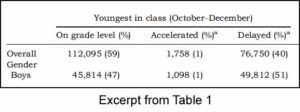 Journal of Child Psychology & Psychiatry, 55(11). 1244-1250.
Journal of Child Psychology & Psychiatry, 55(11). 1244-1250.
In this study in Denmark, similar to the Zoega et al (2012) study in Iceland, the authors wanted to see if the younger children were more at risk of being prescribed ADHD medications. Overall, they were not – or to put it another way, the difference seen at first, in which the youngest children were up to 1.52-fold more likely to be given ADHD medication, was reversed over time. Thus, in 2011-2012, the youngest children were actually 17% less likely to be using ADHD medication than the older children.
In discussing why their results were different from those of studies in Iceland and the U.S., the authors pointed out that in general ADHD medication is very rarely prescribed in Denmark (0.9%), compared to North America (4.6%) and Iceland (4.7%) in 2007.
They also mentioned that those children who were not in their age-assigned grades were not included. In looking at Table 1 (see excerpted portion above), it appears as if they are very generous in allowing younger children to be assigned to a lower grade class. Overall, 40% of children — and 51% of boys — were in the “delayed” group, while relatively very few were pushed ahead to be the youngest in a higher grade.
NOTE: This may be a very wise policy which we should probably emulate in our schools.




















